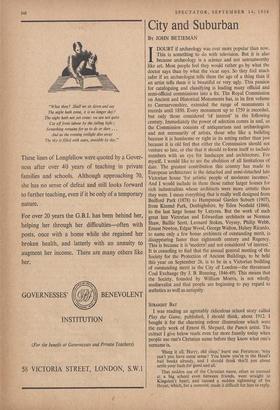City and Suburban
BY JOHN BETJEMAN IDOUBT if archmology was ever more popular than now. This is something to do with television. But it is also because archwology is a science and not untrustworthy like art. Most people feel they would rather go by what the doctor says than by what the vicar says. So they feel much safer if an archxologist tells them the age of a thing than if an artist tells them it is beautiful or very ugly. This passion for cataloguing and classifying is leading many official and semi-official commissions into a fix. The Royal Commission on Ancient and Historical Monuments has, in its first volume to Caernarvonshire, extended the range of monuments it records until 1850. Every monument up to 1750 is recorded, but only those considered 'of interest' in the following century. Immediately the power of selection comes in and, as the Commission consists of antiquarians and archxologists and not necessarily of artists, those who like a building because it is handsome or right in its setting rather than just because it is old feel that either the Commission should not venture so late, or else that it should re-form itself to include members with an eye for landscape and architecture. For myself, I would like to see the abolition of all limitations of date. The greatest contribution this country has made to European architecture is the detached and semi-detached late Victorian house 'for artistic people of moderate incomes.' And I would include in these those rather larger houses for rich industrialists whose architects were more artistic than they were. I mean everything that is really well designed from Bedford Park (1878) to Hampstead Garden Suburb (1907), from Kinmel Park, Denbighshire, by Eden Nesfield (1866), to the last large house by Lutyens. But the work of such great late Victorian and Edwardian architects as Norman Shaw, Baillie Scott, Leonard Stokes, Voysey, Philip Webb, Ernest Newton, Edgar Wood, George Walton, Halsey Ricardo, to name only a few house architects of outstanding merit, is disappearing faster than eighteenth century and Regency. This is because it is 'modern' and not considered 'of interest.' It is consoling to find that the annual general meeting of the Society for the Protection of Ancient Buildings, to be held this year on September 26, is to be in a Victorian building of outstanding merit in the City of London—the threatened Coal Exchange (by J. B. Bunning, 1846-49). This means that the Society, founded by William Morris, is not wholly medimvalist and that people are beginning to pay regard to wsthetics as well as antiquity.


































 Previous page
Previous page